Part 1: 1925 to 1960
1925
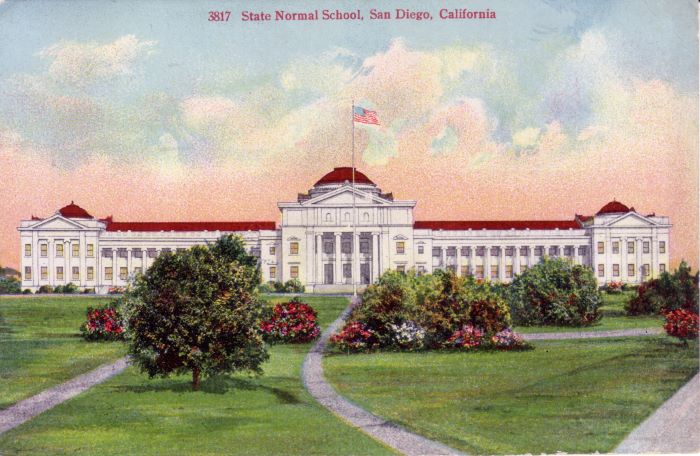 Open the image full screen.
Open the image full screen.
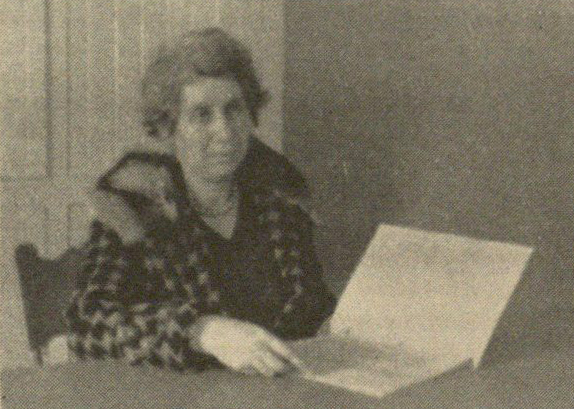
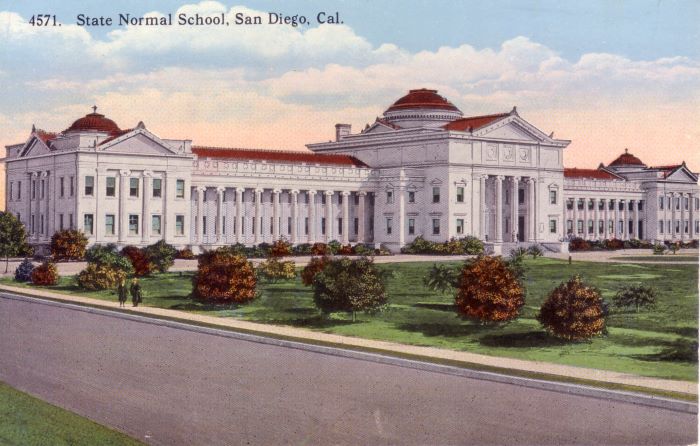 Open the image full screen.
Open the image full screen.
1929
A groundbreaking ceremony for the new home of San Diego State was held in 1929, and, with speed, the new buildings were completed in 1930. So, the University Heights campus immediately moved to the “forty acres” site in the same year, where it has remained.
1932
Paul Pfaff joined the faculty two years later, in 1932. This was a marked addition because Pfaff evidenced interest in speech and language impairments from the early days of his teaching career and was the first SDSC faculty member to work with students with speech problems. According to Dr. Earnest, he was particularly interested in the field of stuttering and set up office hours in his off-campus office on University Avenue, where he gave help gratis. Pfaff retained a strong interest in stuttering, later teaching a course on the subject for many years.7 He was also very interested in aphasia. In the 1940s, he agreed to accept from the Navy Hospital in Balboa Park a young man who, through injury on duty, had lost all speech. He was to be given a discharge. The Navy provided records of his pre-injury I.Q and ability in school. For over a year, Pfaff spent every spare moment assisting the young man in re-learning language skills. Approximately a year after Dr. Pfaff accepted the case, the young man took the same I.Q. test, on which he scored at approximately the original level. He spoke sufficiently fluently that the Navy reinstated him at that pre-injury level. According to Dr. Earnest, the thousands of hours put in by Dr. Pfaff were freely given, that is, without recompense.8 During the early 1930s, soon after he joined the faculty in 1932, Pfaff (who later earned his Ph. D.) took over testing speech skills of SDSC students, and worked with them to improve their speech. Speech improvement sessions would have included work on articulation, voice, fluency (stuttering), and language expression. Pfaff also coached debaters very effectively. He spoke in a grand and eloquent voice, which was deep in pitch and rich in timbre. His vocal skills would have served him well in any professional field, particularly acting, radio announcing, and politics. He was a charismatic figure, commanding attention, especially when he spoke.9 In an SDSU 360 Fall, 2009 issue, a former student of his in the 1940s, Virginia Smith Richardson, class of ’49, remembered Pfaff as “very demanding, but never unfair.” She further commented “He had a knack of seeing the possibility in every student.”10
1941
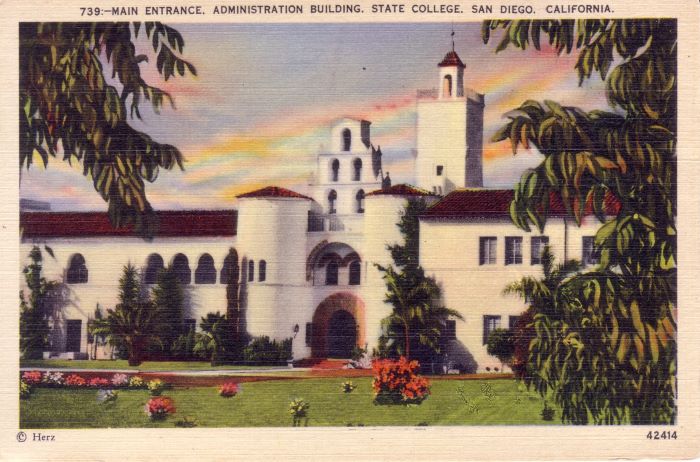 Open the image full screen.
Open the image full screen.
1947
Pfaff kept up that relentless pace of teaching, testing and providing speech correction services until he was joined in 1947 by another faculty member, Sue Earnest, who shared his many interests, including speech correction. She was a 1928 graduate of SDSC. For another reason, 1947 was an important year. In that year, Governor Earl Warren signed legislation that designated San Diego State College a four-year liberal arts institution. After that, it was no longer known as a teacher’s college. Jones died in 1948, one year after Dr. Earnest arrived, and was referred to with great affection by faculty and students for many years.
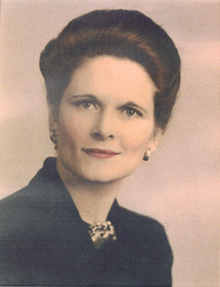
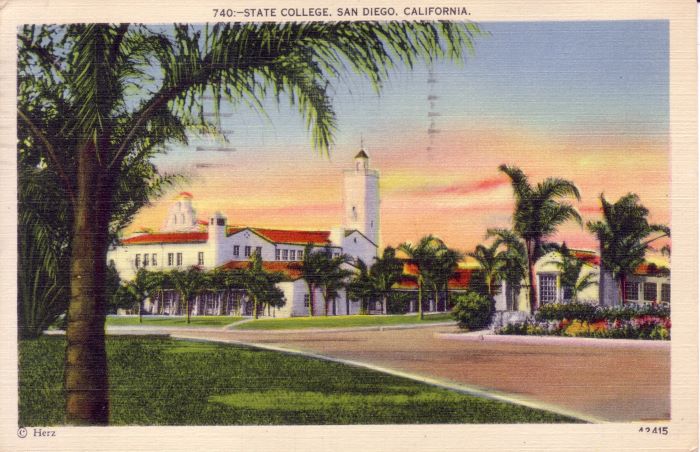 Open the image full screen.
Open the image full screen.
1949
By 1949, “the famous speech test for all entering students continued. The speech department faculty called the speech labs their ‘bread and butter’ course.”14 Speech department faculty participated in teaching required public speaking classes. In those classes, all students were tested for possible speech disorders, remembers Nancy Reed Gibson. A diagnostic passage was read aloud by each student. If that test were failed, the student was referred to speech clinic for treatment. Reed Gibson remembers that process in effect from 1946 over the next 10 years, after which Dr. Earnest took over supervision of testing duties. Evidently, the speech tests became a heavy overload for speech faculty. “I remember giving 400 such tests in one semester. Emphasis was on the Speech Correction Teaching Credential.” Earnest also supervised practice teachers as overload; that is, in excess of her assigned teaching and faculty duties.
1950
All speech faculty members taught 12 units, including Ken Jones, who spent endless hours establishing the 1950 experimental program.15 Presumably, that experimental program involved early campus radio programming. Ken Jones was the founder and implementer of radio and television on the San Diego State College campus, with call letters of KEBS in the days before emerging later as KPBS, San Diego’s Public Broadcasting station. According to Hayes Anderson, the radio curriculum was established in the 1950s, and Ken Jones was able to get funding for educational programming.16 Anderson describes how theatre professor Hunton Sellman gave Ken Jones a closet in the back of the Little Theatre to develop and broadcast programs on campus.17 All these historical tidbits underscore how effectively the Speech Arts faculty functioned with few financial resources.
Ken Jones was an interesting guy, a man with a Bachelor’s Degree from Northwestern University and a Master’s Degree from Stanford. He won the best acting award at Northwestern, winning the honor over fellow classmate Charlton Heston. He maintained that love of theatre and directed some theatre productions at San Diego State. He had a commanding speaking voice and probably could have made a career of acting had he chosen to do so. Instead, he fixed his attention upon the field of broadcasting and used his devotion to academia to create a strong broadcasting curriculum, as well as to lay the foundation for viable radio and television stations.18
Perhaps the influence of Ken Jones led Dr. Earnest to undertake a television series regarding speech disorders and treatment. Reed Gibson recalls the series was produced during the 1950s in the studio of a commercial television station opposite the El Cortez Hotel in downtown San Diego. On the estimated four to six programs, Dr. Earnest appeared and defined and discussed speech disorders such as voice, articulation, stuttering, cerebral palsy, cleft palate, and hearing impairment. Then, two clinicians, Nancy Reed and Janice Quigg, worked with specific clients, demonstrating therapy techniques.
As early as 1949-1950, Dr. Earnest placed SDSC student clinicians at Memorial Junior High School, where they would conduct therapy with young students. This program lasted at least two semesters, maybe more, according to Reed Gibson.
Ken Jones, along with other members of this remarkable faculty, left a huge legacy. As busy as faculty were with overload academic assignments, all of the professors took on even more projects, for no additional pay. But, this kind of forging ahead by faculty was ubiquitous at SDSC at that point in time: in the history department (the legendary chronicler of history Abraham Nassatir and another historian Lionel Rideout); art department (painters Everett Gee Jackson, George Sorenson, Jean Swiggett, sculptor John Dirks, soon to arrive potter Martha Longenecker), and music (composer David Ward Steinman); as well as other disciplines. SDSC was a center of creativity and experimentation. For example, in September of 1950, three professors of the Speech Arts Department, Dr. Sue Earnest, Ken Jones, and Hunton Sellman, collaborated on a production “Pageant of the Golden Pueblo,” which was part of the California Centennial Celebration. The pageant was performed at Presidio Park.
The San Diego Union reported “Dr. Earnest and Jones spent nearly 1000 hours in research in preparation for the script for the pageant, which will be staged Sept. 2 through 9 in the newly christened Centennial Bowl in Presidio Park. Sellman will direct the production.”19 Sellman had been recruited to San Diego State from the University of Iowa, and he was a foremost authority on stage lighting. His published textbook on the subject became the authoritative source for theatre students for decades, and was reissued in multiple editions. Sellman also played a pivotal role in forming San Diego State’s and The Old Globe Theatre’s National Shakespeare Festival at the Globe in 1949. State and the Globe collaboratively presented the Shakespeare Festival for three years. The much admired international expert on Shakespeare, and director of the 1935 Globe Players at the Globe Theatre during the 1935 Exposition in Balboa Park, B. Iden Payne, joined with Craig Noel, Lowell Davies, Hunton Sellman, and, of course SDSC President Malcolm Love, to produce the Shakespeare Festival from 1949 through 1952. Many of the Festival actors were SDSC theatre students. So, although faculty were very busy with departmental teaching duties, it continually reinvented its role and created new opportunities. Although not all discipline initiatives were collaborative, there was very strong support by all faculty for specific endeavors. Again, this particular faculty had boundless energy.
In the same year of the Pueblo Pageant and a summer Shakespeare Festival and countless other undertakings by the small in number, but high energy Speech Arts faculty, a speech correction specialization for students was in a formative stage. Although individual faculty continued to work with selected speech impaired clients as time permitted, midcentury marked the beginning of formal student clinician training at SDSC. That year, teenagers diagnosed with cerebral palsy were seen for therapy by student clinicians. Earnest’s notes clearly reflect her concern with the total well being of the cerebral palsied clients, from communication skills to family education to providing opportunities for socialization. Student clinicians joined in dance sessions with the clients following speech instruction, in order to provide social interaction. Earnest regarded the group dance classes as essential to the habilitation of students with cerebral palsy.20 Hers was a holistic approach to therapy, and reflected social-habilitative theories of the era.
1952
A Saturday Speech and Hearing program was developed in 1952 by Earnest and graduate student Nancy Reed. Parents of children who had speech and hearing impairments enrolled in a one unit extension class that met evenings. So, not only were children clinically treated, but parents were educated about their children’s communication needs.21 Earnest: “Met in Ts, lower floor old library, 2nd floor music building. 95 children, 14 student clinicians. 8-1. 1 fac, 2 master’s level, Reed and Harris… parent class one night a wk… Ed Thile.”22
Nancy Reed shared recollections in interviews.23 Indeed, she recalled the first therapy rooms were in the basement of the old library. She also remembered the pride about the fact that every therapy room was equipped with a tape recorder. In sessions there, students’ speech and voices were recorded and played back for the students to hear, “and they didn’t recognize their own voices,” remarked Reed Gibson (still true in 2013 as many therapists will attest). Reed Gibson also recalled that she suggested the formation of a children’s clinic as her Master’s Degree project to Dr. Earnest. As a result, in 1953, Dr. Earnest and Reed co-founded the SDSC Children’s Speech Clinic, which, as noted earlier, met on Saturdays each week. Ed Thile was one of the beginning level student clinicians to provide therapy with children in the clinic, which Reed directed and coordinated. Dr. Earnest supervised all therapy with the children. Reed’s recollection was that student clinicians earned hours toward their credentials, but earned no college credits for the therapy. The Children’s Clinic continued to operate on Saturdays for several years until it was established on a weekday basis.
According to Reed Gibson, and in Earnest’s notes, Dr. Richard Barbour, who wrote a weekly column for the San Diego Evening Tribune and was an administrator at San Diego City Schools, as well as a friend of Dr Earnest, wrote an article about the SDSC Children’s Speech Clinic for the Tribune. This created a lot of interest within the San Diegocommunity. Barbour’s column was a “must read” among San Diegans in the 1950s. Reed thought the SDSC Children’s Speech Clinic certainly benefited from media attention. In an Evening Tribune article titled “Speech Clinic Offered Free for Youths,” it stated, among other things, “Nancy Reed, graduate student, will have charge of the clinic, open every Saturday from 9a.m. to noon until June. Her assistant is Marcia Harris (who joined the SDSC Speech Pathology and Audiology faculty in the 1960s) and student correctionists are Joan Ferguson, Elizabeth Kenney (later Ecke), Rosemary Rowlands (later Pierce), Eula Brattmiller and Genevieve Oliphant.”24 Reed stated to the interviewer that she recommended discontinuation of the Children’s Speech Clinic thesis topic.25
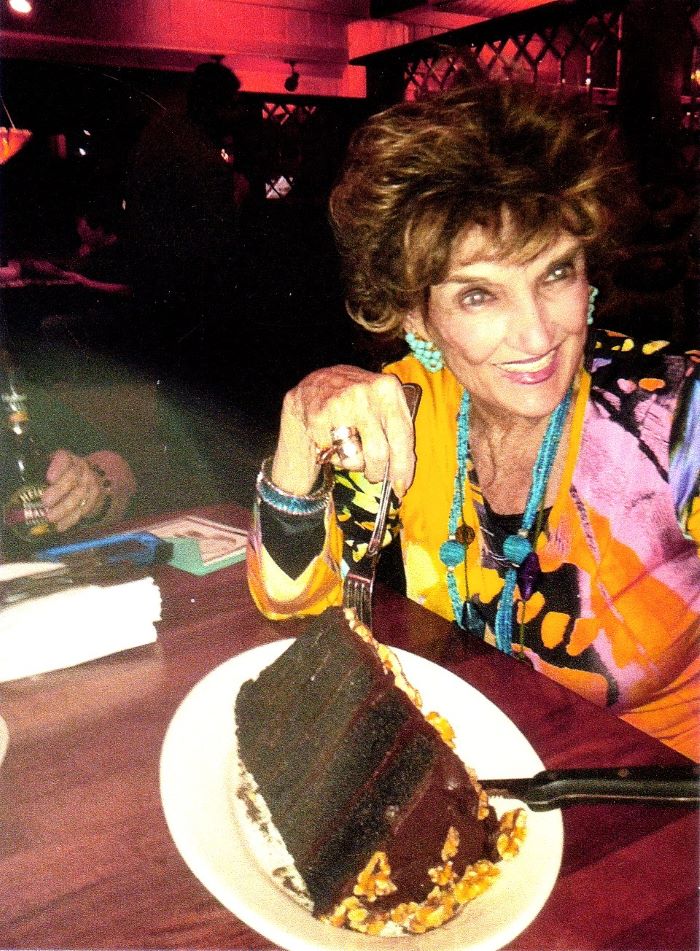
1953
Always, Earnest was an active recruiter on behalf of the speech therapy strand. Her enthusiasm and charisma drew many students to the field from other majors. It was impossible to say “no” to the dynamo referred to affectionately as “Dr. Sue.” She was a charmer who influenced all who entered her sphere.28 She lived to be 100 years old, and her birthday party was held at University House, hosted by President Steven Weber. Attendance at that 100th bash was at maximum capacity. It should also be noted that Earnest is the only three time recipient of the Monty Award (complete list of past CHHS Alumni and Faculty Monty awardees since 1972), the highest SDSU accolade to outstanding alumni.29 In 1953, Broca’s organization was formed and students aspiring to become speech therapists were invited to join. Broca’s was a success, functioning productively until 1965, when its name was changed to Sigma Alpha Eta.30
Dr. Lee Edward Travis, routinely referred to as “the father of speech pathology in the United States,” a noted scholar on the subject of stuttering and associated neurological research, frequently traveled to visit Earnest and Pfaff from his home in Los Angeles, where he was an esteemed professor at the University of Southern California.31 He delivered special talks and lectures. Travis had been part of the history of stuttering research with other notables in the field like Wendell Johnson and Charles Van Riper. As the study of speech therapy advanced at SDSC, Dr. Pfaff, and then Dr. Earnest, took students on field trips to USC, where they sat in Travis’ classes and conversed with the elegant thinker. Dr. Earnest also accompanied her students on field trips to the world famous John Tracy Clinic for the Deaf in Los Angeles. Reed recalled many illustrious guest teachers who came to teach at SDSC’s speech therapy strand in summertime. Among them were Kenneth Scott Wood, George Kopp and the Bobaths.
1954
Psychometric testing by psychology and services of a play therapist were added to clinic activities in 1954. Earnest noted that during 1954, parents of children receiving speech therapy attended class.32
1956
By 1956, the clinic was scheduling children for diagnosis and therapy throughout the days on Monday and Wednesday at hour intervals, with older children attending after school, from 3:30-6:30 p.m. Reed taught the first parent class and continued to do so for a couple of additional years. She required parents to keep journals regarding their interactions with their children, and she introduced role playing. Language development was a large focus of the parent class. Thile led the parent group several times. For at least a year, Clayton Bennett, an educator in the public school system, was the faculty person appointed to teach extension class #175 for parents. “Parents had a choice of two parent groups: 1) a course on direct methodology in speech therapy; or 2.) a group psychotherapy course. The latter was recommended to those thought to have children with emotional problems. The standard test battery was: articulation test, hearing test, intelligence test, and auditory memory plus a case history and the Vineland Test of Social Maturity.”33 In 1956, contact was made with the American Cancer Society to offer esophageal speech lessons to laryngectomy clients in the clinic.34
By 1956, there were increased services for laryngectomies, stutterers, and aphasics, as well as additional support from community groups such as Zonta.35 The department now met ASHA (American Speech & Hearing Association) standards, an important milestone in the School’s history.36
The closeness of faculty and students persisted during this time. To keep a perspective of the Speech Arts department during the 50s, it’s useful to conjure a picture of the annual Christmas hay ride, where students in the department climbed into the back of a large truck/wagon filled with hay, and sang holiday carols as they were driven to faculty members’ homes and greeted by teachers with mugs of hot apple cider, bowls of spicy chili, steaming tamales, and fruit punch. There was a sense of family and, to some extent, naiveté that marked the department during its early years. As the nation became more complicated, the field of speech pathology also developed sophistication in its research and treatment methods.
1957
The broadcast of the television series about speech impairments and SDSC services in 1957 (alluded to earlier) resulted in a large number of applications for clinic enrollment by parents.37 The clinic was in great demand.
As viewed now, the 50s were a time of evolving specialty fields, each in embryonic educational stages: radio and television, with radio a few steps ahead in its delivery; drama, which was produced in the Little Theatre on the main quad, a venue woefully inadequate in its physical dimensions. There were backstage loading and scenery construction areas, and, of course the theatrical wizardry of faculty and staff. John Ackley coached winning debate teams in this last period of his faculty tenure. A future member, and leader of the United States Joint Chiefs of Staff, Air Force General Tony McPeak and his wife, Eleanor, were terrific debaters, as were a number of other students. Dr. Ackley was truly revered by everyone who worked with him at San Diego State. Dr. Robert Benjamin also added strength to the public speaking activities. Dr. Jack Mills would soon be added to this branch. So, the Public Address/Rhetoric aspect of Speech Arts was vital.38
A cultural side note is that the popularity of community groups devoted to speaking skills was great. Many people in San Diego and elsewhere were members of Toastmasters and Toastmistresses clubs, including Dr. Earnest. She and the rest of the faculty delivered many speeches to community groups on behalf of their projects. This was particularly true of those faculty members associated with the speech clinic, in efforts to gain public support and to attract clients to the clinic. Reed Gibson recalls speaking engagements with various PTAs in the county. The speech therapy strand was running a clinic for the community, as well as providing speech correction and improvement instruction to students with communication impediments.39 As Dr. Earnest would most likely have expressed it, things were really humming. When retired Professor Robert Lee was interviewed on 10/28/09, he remembered “Dr. Sue” with great admiration.”40 Sue could pull anything off. She asserted herself, but had a positive attitude and could get you to do anything. All of the speech faculty members had very strong personalities. They were high energy, yet they were very generous with one another. Pretty amazing, and that’s how so much was accomplished.”41 There’s no doubt the speech arts department was sorting things out, defining special interests and areas of activity. Yet, as the strands pulled away from one another, they also supported each other. Lee said that wasn’t true of some other departments on campus that were in turmoil and experiencing dissension.
1958
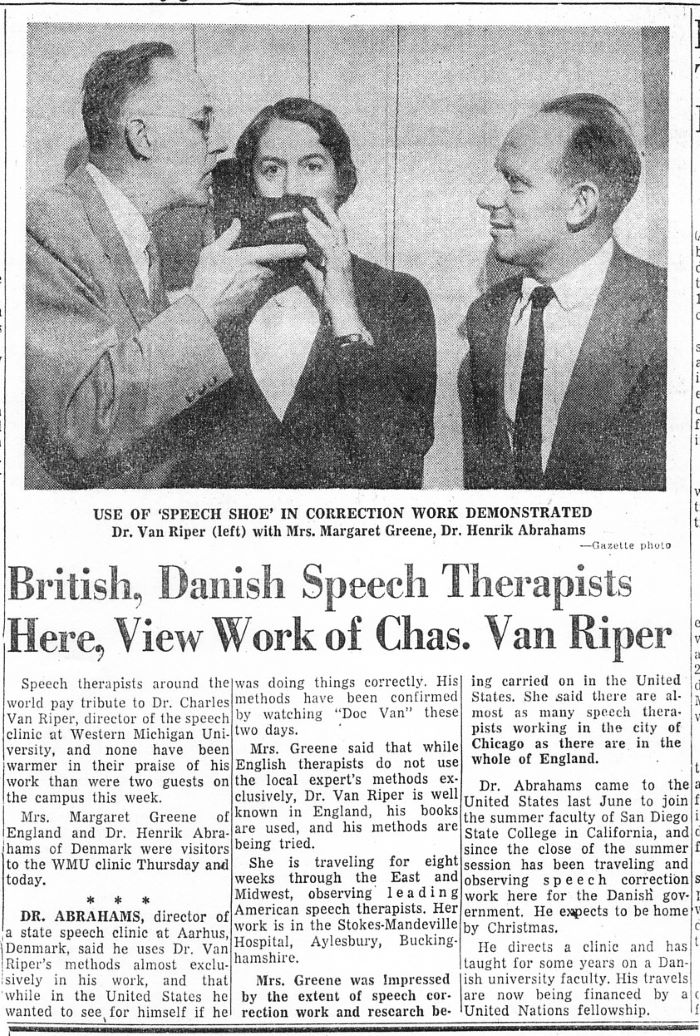
These provisions were a long way from laptops, blackberries, and computer notebooks, but were quite organized. No instant messaging, Facebook or Twitter, but the process worked quite efficiently. In fact, this setup was state of the art for the time and it elevated the professional level of clinical services. It was quite something!
There was an audiological assessment room, again with one-way mirror, and there was also a sizeable conference room that could be observed. It worked well for group therapy, counseling and parent education classes. Weekly staffing meetings were held, and at those meetings, each clinician presented one case he or she was treating. At that time, the mid-20th century, the professional importance of confidentiality was strongly stressed. In the 21st century, the challenge of privacy and confidentiality has become an almost unmanageable undertaking, due to advances in technology; strides that were unimaginable in 1958.
Dr. Henrik Abrahams, director of a state speech clinic at Aarhus, Denmark, joined the SDSC summer faculty in 1958, and, according to the October 31, 1958 Kalamazoo Gazette “since the close of the summer session has been traveling and observing speech correction work here for the Danish government. He expects to be home for Christmas.” Dr. Abrahams stated he utilized Charles Van Riper’s methods “almost exclusively in his work, and that while in the United States he wanted to see for himself if he was doing things correctly. His methods have been confirmed by watching “Doc Van” these two days.”44 The photo accompanying the Kalamazoo Gazette article pictured Dr. Van Riper demonstrating the use of a “speech shoe,” while therapists Mrs. Margaret Greene of England and Dr. Abrahams watched.
1959
The speech pathology strand was increasingly active by 1959. Reed was appointed a Lecturer in the mid-50s. Thile, who had been one of the original student clinicians in the fledgling 1950 children’s clinic, joined the staff, providing counseling and speech services. At the same time, there was intensive planning for the new Clinical Training Center site. CTC, as it was called, was designed to be used by speech pathology and audiology, education and psychology.45 A multi-disciplinary approach was designed, so that each discipline would conduct testing and its own diagnostic work, coming together collaboratively to make the best recommendations and to design the best courses of action for clients. That might include therapy, referral to other agencies, or education of families and caregivers. The multidisciplinary approach to management of educational, psychological and communication problems offered a more comprehensive view of habilitation and rehabilitation of children and adults.
Something more momentous took place in 1959, and it was on a grand state-wide scale, which eventually influenced educational institutions in countries around the world. That is when the exploding number of colleges and universities in California reached a crisis of governance and legal missions. Former California State Librarian and historian, Kevin Starr, pointed out that the postwar educational boom in education had produced greater numbers of students and many more Ph.D.s, “many of whom were taking jobs in the state colleges and were increasingly resentful of the fact that they were teaching twice as many courses as their UC counterparts (four courses per semester as opposed to two) and were discouraged from doing research.”46
1960
No client services were denied because of inability to pay. For some years, there was no charge for therapy services, then therapy on a sliding scale was instituted, though there was no charge to SDSC students. A Director of the CTC position was established, and that person oversaw the various teams from separate disciplines, bringing them together for review and discussion of cases. This multidisciplinary approach was advanced and offered terrific training to clinicians. This same year, 1960, Dr. Earnest brought Dr. Muriel Morley from Newcastle-on-Tyne, England for a six weeks summer school presentation.47
The area of radio and tv was progressing, for it was in 1960 that the FM radio station KEBS, the forerunner of KPBS, was legally established.48 The speech clinic in the new facility opened in 1960, also, where space was shared with Thile and psychology.49 At the same time, the American Speech and Hearing Association (ASHA) was strengthening and was actively working to refine clinical site and clinician certification. As a result, the professional field was more focused and accountable. Part of the speech therapy strand was now physically separated from the building which housed speech arts, though some speech therapy faculty offices remained in the same building shared with other Speech Arts faculty. But the move to the new building across campus on the east side marked the beginning of the separation of the strands and the foundation of what would be official in future years, when all four disciplines would become individual formal majors in the SDSC curriculum.50 Clearly, 1960 was a turning point in the history of the School of Speech, Language and Hearing Sciences.
.
.
- Materials from Sybil Eliza Jones Collection at San Diego State University Special Archives
- Starr, Raymond, San Diego State University A History in Word and Image, p. 47
- Ibid., p. 55.
- Ibid.
- Notes of Dr. Sue Earnest circa 1990s
- Special Collections, SDSU. SDSU class catalogs of 920s. Notes of Dr. Sue Earnest
- Notes of Dr. Sue Earnest
- Ibid.
- Author’s recollections as former student of Dr. Pfaff in the 1950s and 60s
- Remembrances of Virginia Smith Richardson, a student of Dr. Pfaff at SDSC in the 1940s. Richardson was quoted in the Fall 2009 issue of 360 magazine
- Notes of Dr. Sue Earnest
- Ibid.
- Ibid.
- Ibid.
- Ibid.
- Ibid.
- Remarks of Hayes Anderson at the memorial service for Ken Jones in the KPBS TV studio on November 21, 2009
- Ibid., Obituary of Ken Jones in San Diego Union, October 28, 2009
- “Trained Trio Sets Stage for ‘Pueblo,’ The San Diego Union, August 20, 1950
- Notes of Dr. Sue Earnest
- Ibid.
- Ibid.
- Interview of Nancy Reed Gibson on April 14, 2009. Additional interviews on December 10 and 11, 2010
- “Speech Clinic Offered Free for Youths,” San Diego Evening Tribune, February 26, 1953
- Nancy Reed Gibson interviews
- Interviews with Rosemary Rowlands Pierce in 2009
- Interview with Elizabeth Jinx Ecke on July 9, 2010
- Author’s recollections
- Records of SDSU Alumni Association
- Notes of Dr. Sue Earnest
- University of Southern California catalogs. Published texts by Dr. Travis. Historical materials of American Speech Language Hearing Association. Recollections of author.
- Notes of Dr. Sue Earnest
- Ibid.
- Ibid.
- Ibid.
- ASHA published standards
- Notes of Dr. Sue Earnest
- All from author’s recollections
- Notes of Dr. Sue Earnest
- Interview with Professor Emeritus Robert Lee on October 28, 2009
- Ibid.
- Notes of Dr. Sue Earnest
- Author’s recollections
- Kalamazoo Gazette, October 31, 1958
- Notes of Dr. Sue Earnest
- Kevin Starr, GOLDEN DREAMS California in an Age of Abundance 1950-1963, Oxford University Press, 2009, p. 234
- Notes of Dr. Sue Earnest
- KPBS records
- Ibid.
- Notes of Dr. Sue Earnest; Hayes Anderson’s remarks at the memorial service for Ken Jones in the KPBS TV studio on November 22, 2009. Hayes Anderson was a long-time professor in the departments of Speech Arts and then Telecommunications.
All Images, with the Exception of Rosemary Rowlands, Courtesy of SDSU Library Special Collections; Rosemary Rowlands Photo Courtesy of Rosemary Rowlands Pierce
Contact Us
SDSU Speech Language and Hearing
San Diego, CA 92182-1518
